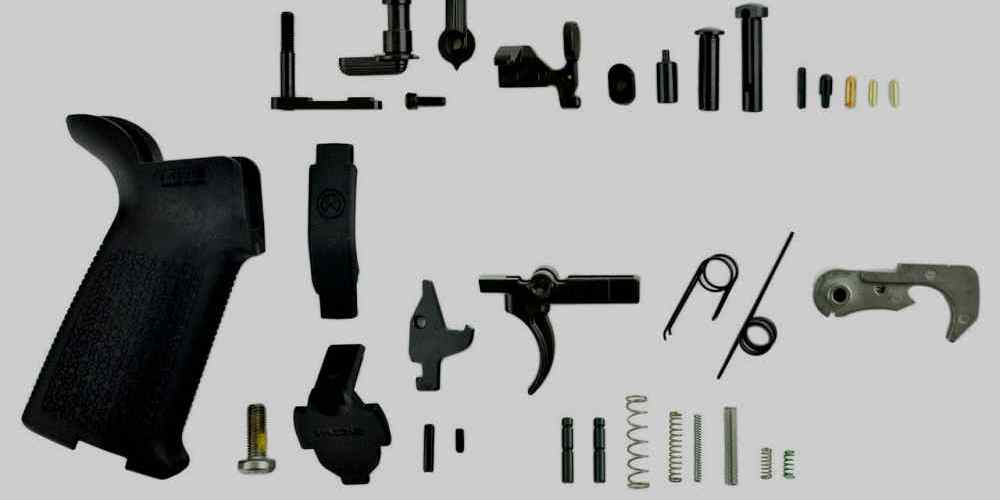“Precision fit for peak performance.”
Importance of Lower Receiver Fitment in AR15 Builds
When it comes to building an AR15, one of the most critical aspects to consider is the fitment of the lower receiver. The lower receiver is the foundation of your rifle, and ensuring a tight and accurate fit is essential for optimal performance. In this article, we will discuss the importance of lower receiver fitment in AR15 builds and provide some tips on how to achieve a perfect fit.
Proper fitment of the lower receiver is crucial for several reasons. First and foremost, a tight fit ensures that the components of your rifle are aligned correctly, which is essential for accuracy and reliability. A loose or improperly fitted lower receiver can lead to issues such as misalignment of the upper and lower receivers, which can affect the overall performance of your rifle.
Additionally, a properly fitted lower receiver can help prevent malfunctions and improve the longevity of your rifle. When all components are aligned correctly, there is less stress on the parts, which can help prevent premature wear and tear. This, in turn, can help extend the life of your rifle and ensure that it functions reliably for years to come.
Achieving a tight and accurate fit for your lower receiver starts with selecting high-quality components. When choosing a lower receiver, look for one that is made from a durable material, such as aluminum or polymer, and has a reputation for precision machining. Investing in a quality lower receiver will not only ensure a better fit but also improve the overall performance of your rifle.
Once you have selected a high-quality lower receiver, the next step is to properly install it. Start by ensuring that the lower receiver is properly aligned with the upper receiver. This can be done by inserting the front takedown pin and pushing the rear takedown pin into place. If the pins do not slide in easily, you may need to adjust the fit of the lower receiver.
To achieve a perfect fit, you may need to make some minor adjustments to the lower receiver. This can be done by using shims or spacers to fill any gaps between the upper and lower receivers. Additionally, you may need to file down any excess material on the lower receiver to ensure a snug fit. Take your time during this process and make sure that all components are aligned correctly before moving on to the next step.
Once you have achieved a tight and accurate fit for your lower receiver, it is essential to test the functionality of your rifle. Check for any play or movement between the upper and lower receivers and make any necessary adjustments. Additionally, test fire your rifle to ensure that it functions reliably and accurately.
In conclusion, lower receiver fitment is a critical aspect of building an AR15. A tight and accurate fit ensures optimal performance, reliability, and longevity of your rifle. By selecting high-quality components, properly installing the lower receiver, and making any necessary adjustments, you can achieve a perfect fit for your AR15 build. Take your time during this process and pay attention to detail to ensure that your rifle functions flawlessly for years to come.

Common Issues with Lower Receiver Fitment
When it comes to building your own AR15, one of the most crucial aspects to pay attention to is the fitment of the lower receiver. The lower receiver is essentially the backbone of your rifle, as it houses the trigger group, magazine well, and buffer tube. Ensuring a tight and accurate fit between the lower receiver and other components is essential for the overall performance and reliability of your firearm.
One common issue that many builders face when assembling an AR15 is poor fitment between the lower receiver and upper receiver. This can result in a loose connection between the two components, which can lead to accuracy issues and potential malfunctions. To avoid this problem, it is important to carefully inspect the mating surfaces of both the lower and upper receivers before assembly. Look for any signs of wear or damage that could affect the fitment, and make any necessary adjustments or repairs before proceeding.
Another common issue with lower receiver fitment is the alignment of the trigger group. If the trigger pins are not properly aligned with the corresponding holes in the lower receiver, it can result in a sloppy trigger pull and decreased accuracy. To ensure proper alignment, use a punch or alignment tool to guide the pins into place before securing them with the appropriate hardware. This will help to prevent any movement or play in the trigger group, resulting in a smoother and more consistent trigger pull.
In addition to the trigger group, the fitment of the magazine well is also crucial for reliable feeding and function. If the magazine well is not properly aligned with the lower receiver, it can result in feeding issues and potential jams. To ensure a tight fit, carefully inspect the magazine well for any signs of wear or damage, and make any necessary adjustments or repairs before assembly. Test fit a magazine to ensure that it seats properly and feeds smoothly before moving on to the next step of the build.
One final common issue with lower receiver fitment is the installation of the buffer tube. If the buffer tube is not properly aligned with the lower receiver, it can result in cycling issues and potential malfunctions. To ensure a tight fit, use a castle nut wrench to secure the buffer tube to the lower receiver, making sure that it is properly aligned and tightened to the correct specifications. This will help to prevent any movement or play in the buffer tube, resulting in smooth and reliable cycling of the action.
In conclusion, ensuring a tight and accurate fit between the lower receiver and other components is essential for a successful AR15 build. By carefully inspecting and adjusting the fitment of the lower receiver, trigger group, magazine well, and buffer tube, you can help to prevent common issues and ensure the overall performance and reliability of your firearm. Take your time during the assembly process, and don’t hesitate to seek help or guidance if you encounter any difficulties. With proper fitment and attention to detail, you can build a high-quality AR15 that will serve you well for years to come.
Tips for Achieving a Tight and Accurate Fit
When it comes to building your own AR15, one of the most critical aspects to pay attention to is the fitment of the lower receiver. The lower receiver is essentially the backbone of your rifle, as it houses the trigger group, magazine well, and buffer tube. Ensuring a tight and accurate fit between the lower receiver and other components is crucial for the overall performance and reliability of your firearm.
One of the first things to consider when fitting a lower receiver is the compatibility with other parts. Not all lower receivers are created equal, and some may have slight variations in dimensions that could affect the fitment of other components. It’s essential to do your research and make sure that the lower receiver you choose is compatible with the upper receiver, buffer tube, and other parts you plan to use in your build.
Once you have selected a compatible lower receiver, the next step is to ensure a tight fit between the lower receiver and the upper receiver. A loose fit between these two components can lead to accuracy issues and potential malfunctions. To achieve a tight fit, you may need to use shims or other methods to eliminate any play between the two receivers. Take your time during this step, as a precise fit will pay off in the long run.
Another critical area to pay attention to is the fitment of the trigger group. A loose trigger group can lead to inconsistent trigger pull and affect the overall accuracy of your rifle. Make sure that the trigger pins are properly aligned and secured in place to prevent any movement during firing. Additionally, check for any excess material or burrs that may be interfering with the trigger group’s function.
The fitment of the magazine well is also crucial for reliable feeding and ejection of rounds. A loose magazine well can cause feeding issues and affect the overall performance of your rifle. Make sure that the magazine well is properly aligned and secured in place to prevent any movement during operation. Test the fitment with different magazines to ensure smooth and reliable feeding.
Finally, don’t forget about the fitment of the buffer tube. A loose buffer tube can affect the cycling of the bolt carrier group and lead to malfunctions. Make sure that the buffer tube is properly aligned and secured in place to prevent any movement during firing. Test the fitment by cycling the bolt carrier group to ensure smooth operation.
In conclusion, achieving a tight and accurate fit between the lower receiver and other components is essential for building a reliable and accurate AR15. Take your time during the assembly process and pay attention to the compatibility and fitment of each part. By ensuring a precise fit, you can enjoy a well-built rifle that performs flawlessly on the range. Happy building!
Tools and Techniques for Proper Lower Receiver Fitment
When it comes to building your own AR15, one of the most critical aspects to get right is the fitment of the lower receiver. The lower receiver is essentially the backbone of your rifle, housing the trigger group, magazine well, and buffer tube. Ensuring a tight and accurate fit between the lower receiver and other components is crucial for the overall performance and reliability of your firearm.
To achieve proper lower receiver fitment, you will need a few essential tools and techniques. One of the first steps in the fitment process is to carefully inspect the lower receiver for any imperfections or burrs that may interfere with the installation of other components. Using a fine file or sandpaper, gently remove any rough edges or burrs to ensure a smooth and seamless fit.
Next, it is important to check the dimensions of your lower receiver to ensure compatibility with other components. Different manufacturers may have slight variations in their specifications, so it is crucial to double-check measurements before proceeding with the build. Using a set of calipers, measure the critical dimensions of the lower receiver, such as the pin holes and magazine well, to ensure a proper fit with other parts.
Once you have verified the dimensions of your lower receiver, the next step is to test fit other components such as the trigger group, magazine release, and buffer tube. Carefully install each component into the lower receiver, making sure that they fit snugly and securely without any play or wobble. If you encounter any resistance or difficulty during the installation process, do not force the component into place as this may cause damage to the lower receiver.
In some cases, you may need to make minor adjustments to the lower receiver to achieve a proper fit with other components. This can be done by carefully filing or sanding down areas of the lower receiver that may be interfering with the installation of other parts. Take your time and work slowly to avoid removing too much material, as this can compromise the structural integrity of the lower receiver.
Another important aspect of lower receiver fitment is ensuring proper alignment with the upper receiver. The two receivers should fit together seamlessly without any gaps or misalignment. To achieve this, carefully install the upper receiver onto the lower receiver and check for any gaps or misalignment between the two components. If you notice any issues, you may need to make adjustments to the lower receiver to achieve a perfect fit.
Overall, proper lower receiver fitment is essential for a reliable and accurate AR15 build. By using the right tools and techniques, you can ensure that your lower receiver fits snugly and securely with other components, resulting in a firearm that performs flawlessly. Take your time during the fitment process and pay attention to detail to achieve the best results. With a little patience and effort, you can build a high-quality AR15 that will serve you well for years to come.
How to Troubleshoot Fitment Problems in AR15 Builds
Building your own AR15 can be a rewarding experience, allowing you to customize your firearm to your exact specifications. However, one of the most crucial aspects of a successful build is ensuring that the lower receiver fits properly. A tight and accurate fit is essential for the overall performance and reliability of your AR15. In this article, we will discuss how to troubleshoot fitment problems in AR15 builds to ensure a smooth and successful build.
One common fitment issue that builders encounter is a loose or wobbly lower receiver. This can be caused by a number of factors, including an out-of-spec lower receiver or an improperly installed buffer tube. If you are experiencing a loose fit, the first step is to check the dimensions of your lower receiver to ensure that it is within spec. If the lower receiver is out of spec, you may need to replace it with a properly sized one.
Another potential cause of a loose fit is an improperly installed buffer tube. The buffer tube should be tightened securely to the lower receiver using a castle nut and end plate. If the buffer tube is not tightened properly, it can cause the lower receiver to wobble. To troubleshoot this issue, remove the buffer tube and reinstall it, making sure to tighten it securely.
In some cases, a loose fit may be caused by a worn or damaged buffer tube. If the buffer tube is damaged, it may need to be replaced to ensure a tight fit. Additionally, using a high-quality buffer tube can help prevent fitment issues in the future.
Another fitment issue that builders may encounter is a tight or binding lower receiver. This can be caused by an out-of-spec upper receiver or an improperly installed pivot pin. If you are experiencing a tight fit, the first step is to check the dimensions of your upper receiver to ensure that it is within spec. If the upper receiver is out of spec, you may need to replace it with a properly sized one.
An improperly installed pivot pin can also cause a tight fit. The pivot pin should be installed with the detent and spring to ensure smooth operation. If the pivot pin is not installed correctly, it can cause the lower receiver to bind. To troubleshoot this issue, remove the pivot pin and reinstall it, making sure that it is installed correctly.
In some cases, a tight fit may be caused by a worn or damaged pivot pin. If the pivot pin is damaged, it may need to be replaced to ensure a smooth fit. Additionally, using a high-quality pivot pin can help prevent fitment issues in the future.
In conclusion, ensuring a tight and accurate fit in your AR15 build is essential for the overall performance and reliability of your firearm. By troubleshooting fitment issues such as loose or tight fits, you can ensure a smooth and successful build. Remember to check the dimensions of your lower and upper receivers, as well as the installation of components such as the buffer tube and pivot pin. With proper attention to fitment, you can enjoy a custom AR15 build that meets your exact specifications.






